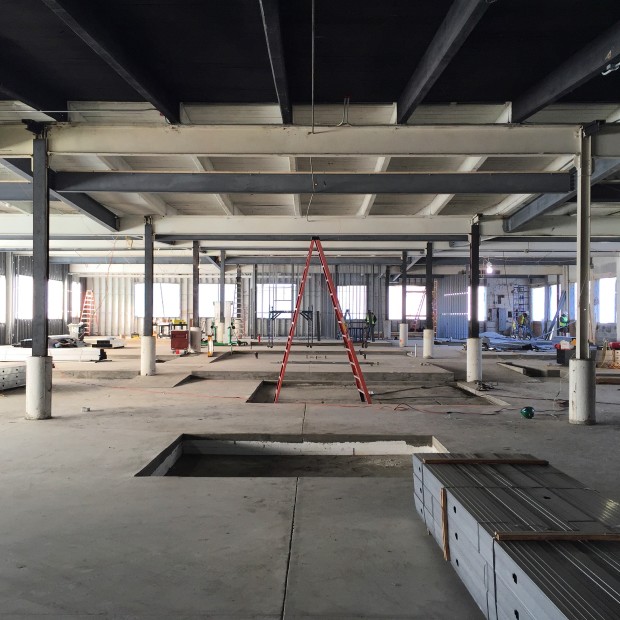
With research and development complete, it was time to commence the hunt for property. However, as anyone who has ever bought a home knows, real estate can be a rabbit hole of ever-increasing complexity. Commercial property development is no different, layered with even more obligations and costs. In order to navigate these waters, we had to float a raft of legal structures.
Open Works’ heritage can be traced back twenty years, to Dr. Robert W. Deutsch. He was a very successful entrepreneur who founded and led two companies in his lifetime: General Physics (1968 – 1987) and RWD Technologies (1988 – 2008). Based on his early work in the nuclear energy field, Dr. Deutsch realized that Fortune 100 companies could transform their organizations with sophisticated technologies for manufacturing, data management, communications, and customer service. He focused his companies on improving employee performance support systems and decreasing the cost of technology integration.
Based on the success of his first venture, General Physics, Dr. Deutsch created the Robert W. Deutsch Foundation in 1988 to provide support for innovative programs in science and technology in institutions of higher education in Maryland. The Foundation was part of his desire to give back to the public sources of scientific discovery and technological innovation on which he had built his career. His philanthropy is a living legacy that continues to invest in innovative people and ideas. Over the last decade, the Foundation has been able to expand its programs to support innovations in the arts, education, neighborhood revitalization, and social justice.
In 2012, the board of the Robert W. Deutsch Foundation formed the Baltimore Arts Realty Corporation (BARCO), a non-profit development company with a mission to create safe, affordable, and accessible space for Baltimore’s creatives. In 2013, BARCO purchased 1400 Greenmount Avenue with the idea of pursuing the development of Open Works. Later that year, they hired me (thank you!).

So what does a development company do? We’re all familiar with construction sites plastered with “Coming Soon” signs that identify a tangle of companies, but it can be hard to sort out all of their roles and responsibilities. In order to get a building built, the developer has to:
1. Find, buy, and hold property to build on.
2. Raise money either from investors and debt (for-profit) or foundations, government agencies, bonds, grants, and debt (non-profit) to build the project.
3. Create a business plan for the building that creates enough profit to satisfy investor and debt obligations.
4. Hire a team of architects, engineers, consultants, lawyers, marketers, and construction professionals to execute the project.
5. Oversee and manage the process from acquisition through to operation.

If you are looking to start a makerspace in your own city, starting your own development company is not the only way to do it. There are a lot of ways to develop, own, and operate a makerspace. If you are looking to simply rent space to operate a makerspace, then you can skip some of these steps, but you’ll still have to create a legal structure for your organization. Here are a few options:
- Limited liability company (LLC): an LLC is the simplest business structure. In most states, they cost only a hundred dollars or so to set up and a little bit of paper work. Taxation is relatively simple, and your personal assets will be insulated from any bankruptcy rulings, lawsuits, or insurance claims.
- Nonprofit: a 501(c)(3) is a tax-exempt organization for the purposes of “charitable, religious, educational, scientific, literary, testing for public safety, fostering amateur sports competition, or preventing cruelty to children or animals.” To set one up, you need to have a precursor organization (an LLC qualifies) and complete (a very long) application. Being a nonprofit will allow you to access grants, government programs, and certain kinds of loans that may be advantageous depending on your location, mission, and audience.
- Public benefit corporation (BCorp): a corporation that has committed to other public-benefit goals other than providing a return on value to shareholders. Patagonia is one of the best-known examples; they have written environmental sustainability, worker rights, and diversity benchmarks into their charter, even though some of those things affect their profitability.
- Community development corporation (CDC): neighborhood-based, non-profit development companies, most focused on creating affordable housing. There are over 4,000 CDCs in the United States — creating a CDC from scratch is probably not a great strategy for developing a makerspace, but an existing one may want to partner on a project.
- Public private partnership (PPP): a contractual arrangement between a government agency and a private entity, usually a company. Common examples include toll roads or hospitals — a government-owned asset that is operated on a contractual basis by service provider. Many states and cities use some form of PPP to develop real estate, particularly in under-invested communities. They often issue Requests for Proposals (RFPs) for vacant publicly-owned property to help turn it around. Makerspaces could be a great use for vacant industrial property held by a PPP.

While financial and legal structures can be a bit boring, they are an absolute essential early step in establishing a makerspace. Without these mechanisms in place, you could be putting your own finances at risk. For further information, the Urban Manufacturing Alliance has a great toolkit for folks looking to re-develop industrial properties.
Next week, we’ll talk about how we put these legal structures to work and found the perfect site for Open Works.
Construction Update
Since the last post, we have:
1. Finished all of the interior concrete work.
2. Framed up most of the walls upstairs.
3. Dug and started pouring foundations for retaining walls on site.
4. Dug and installed our stormwater retention swale in the parking lot to lessen our impact on the Chesapeake Bay.




ADVERTISEMENT





